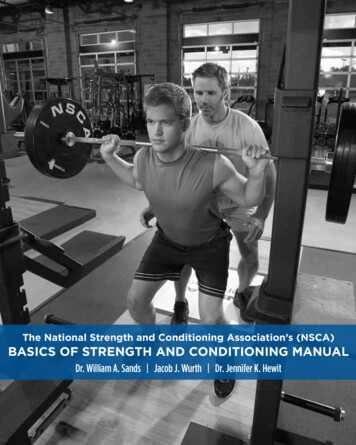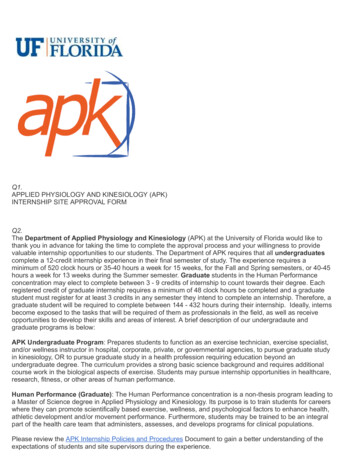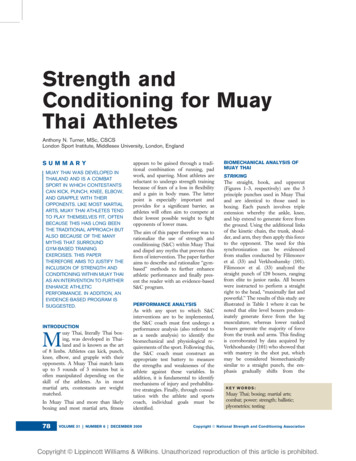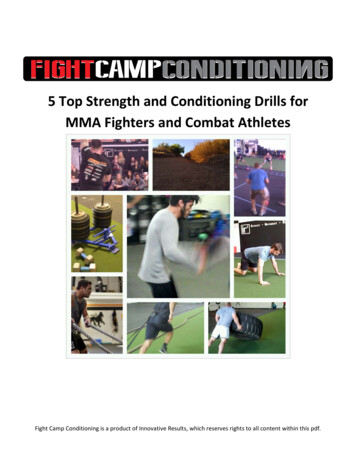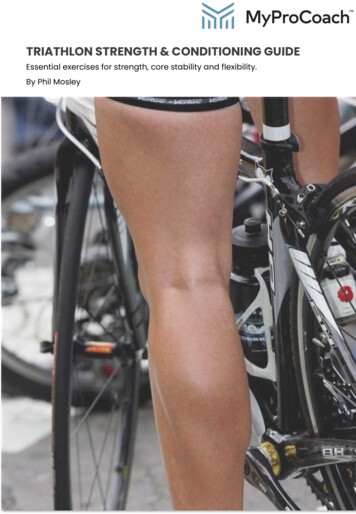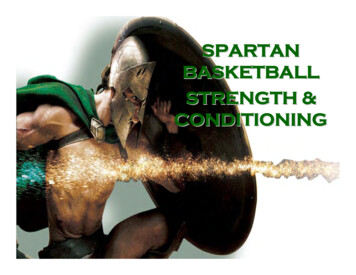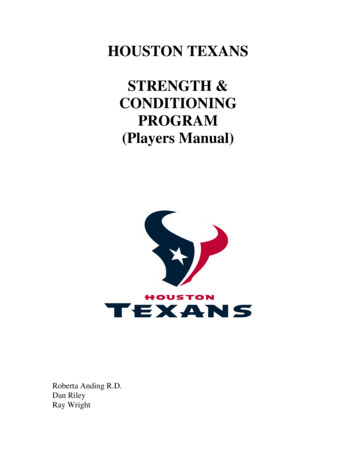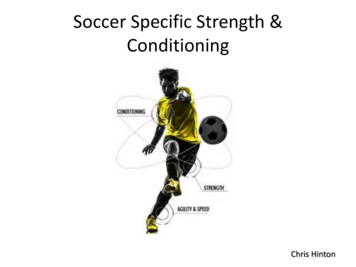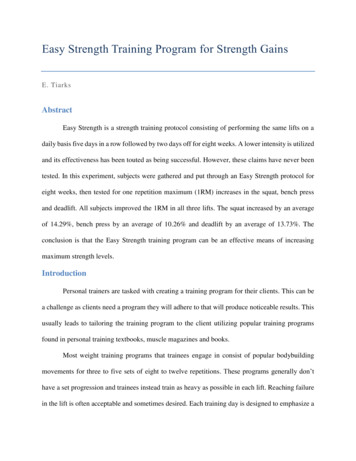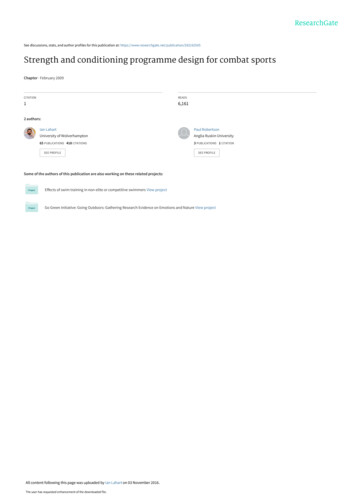
Transcription
See discussions, stats, and author profiles for this publication at: Strength and conditioning programme design for combat sportsChapter · February 2009CITATIONREADS16,1612 authors:Ian LahartPaul RobertsonUniversity of WolverhamptonAnglia Ruskin University65 PUBLICATIONS 418 CITATIONS3 PUBLICATIONS 1 CITATIONSEE PROFILESEE PROFILESome of the authors of this publication are also working on these related projects:Effects of swim training in non-elite or competitive swimmers View projectGo Green Initiative: Going Outdoors: Gathering Research Evidence on Emotions and Nature View projectAll content following this page was uploaded by Ian Lahart on 03 November 2016.The user has requested enhancement of the downloaded file.
ReviewStrength and Conditioning ProgrammeDesign for Combat SportsIan Lahart1 and Paul Robertson11University College Birmingham, UKAbstractEffective strength and conditioning programmes are designed to optimally prepare athletes to meet thespecific demands of their particular sport. Due to the unique and highly specific nature of each combatsport, strength and conditioning professionals are faced with a particularly complex challenge. Thischapter presents an analysis of the three very different combat sports of amateur boxing, taekwondo,and judo. Each of these combat sports requires competitors to perform a diverse range of technicalmovements and skills, elicits a specific metabolic response during actual competition, and necessitatesthe possession of distinct physiological characteristics for performance at elite levels. Therefore,strength and conditioning programme design for each sport requires a different and multifacetedapproach. Sports-specific skill-based high-intensity interval training, Olympic weightlifting exercises,circuit training, plyometrics, and complex training are strength and conditioning methods that can allbe tailored to meet the specific technical and physiological demands of actual competition. Thefollowing chapter provides strength and conditioning professionals with a rationale for these trainingmethods and sample sessions demonstrating how they can be applied to each of the three combatsports.Keywords: Judo, Taekwondo, Boxing, Complex Training, High Intensity Training,PlyometricsThe nature of combat sport is to strike, throw or grapple with an opponent [59]. However,each combat sport is highly individualized and requires unique actions and techniques. Forexample, taekwondo involves only kicks and punches, while judo prohibits punching and kicks infavour of throws and grappling. In addition to this, individual combat sports have differing rules1Please address correspondence and requests for reprints to Ian M. Lahart, Sports Therapy Department, UniversityCollege Birmingham, Summer Row, Birmingham, England, B3 1JB or e mail i.lahart@ucb.ac.uk.
and regulations. For example, in Greco-Roman wrestling only use of the arms and upper bodiesare permitted, whereas in freestyle wrestling, athletes can use their arms, upper body, and legs andmay hold opponents above or below the waist [56]. Furthermore, combat sports have differentcontest formats, for example, judo consists of one continuous 5-minute bout, whereas taekwondocontests consist of three 2-minute rounds [49, 113]. Therefore, due to the different actions,techniques, and contest rules and formats, each combat sports represents a unique challenge to thestrength and conditioning professional.Specifically, this chapter will examine the three combat sports of amateur boxing,taekwondo, and Judo. Along with freestyle and Greco-Roman wrestling, these three combat sportsrepresent the five Olympic combat sports. In accordance with the law of specificity, to beeffective, strength and conditioning programmes for any of these three sports must stress thephysiological systems specific to that particular sport. To do this we must first understand thephysiological effects elicited during and after competition in the sport. Once these effects havebeen analysed, a strength and conditioning programme can be designed to adequately stress thephysiological systems required for competition and simulate the conditions elicited during actualcompetition in the training environment.With this in mind, the first part of this chapter aims to provide strength and conditioningpractioners with the latest findings from the literature in regards to the specific technical andmetabolic demands that these sports place on participants. In addition to this, the physiologicalcharacteristics of elite competitors will be explored to find possible determinants of successfulperformance in each sport. In part two of the chapter, these findings will then be applied to thedesign of strength and conditioning programmes for the three combat sports. Both advanced andtraditional training methods, specific to each sport and supported by scientific evidence, will beinvestigated.
Part I. Technical and Physiological Analysis ofCombat SportsTechnical and Physiological Analysis of Amateur BoxingBoxing is an intermittent contact sport, characterised by bouts of short duration highintensity activity [52]. This high-intensity activity is comprised of a high punching rate andpunching force, and dynamic footwork [94]. Currently, boxing in the Olympics allows onlyamateur participation, and consists of four 2-minute rounds, separated by 1-min rest periods, butthis is due to change to three 3-min rounds in 2009. The aim of boxing is either to score morepoints than your opponent or stop your opponent within the contest duration. A point is scored if apunch is not blocked or guarded but lands directly with the knuckle part of the closed glove ofeither hand on any part of the front or sides of the head or body above the belt, but not on thearms. The outcome of a contest is either decided by the referee within its designated duration, orby 3 to 5 judges using the CSS computer scoring system if the fight goes the distance [1].For strength and conditioning programme design purposes it is important to understandthe energy pathways that predominate during sports competition. The majority of combat sportsrequire a combination of the three energy systems. Combat sports consist of the performance ofintermittent high-intensity short duration bouts of activity, which is predominantly fuelled by theanaerobic pathways of ATP and creatine phosphate (PCr) hydrolysis (phosphate system) and thedegradation of muscle glycogen to lactate (lactate system) [112]. However, a significantcontribution from the aerobic energy system has also been shown in high-intensity exercise lastingjust 6 seconds [36]. Furthermore, this aerobic contribution has been shown to increase when highintensity, short duration activity is repeated or sustained [14, 36, 73]. In addition to this, athlete’swith a high level of aerobic fitness appear to recover faster from high-intensity activity than lessaerobically fit athletes [103]. Thus, although the anaerobic energy systems predominate duringboxing activities, the aerobic energy system has an important role in both the execution of andrecovery from multiple high-intensity activity. The percentage contribution of the anaerobic and
aerobic energy systems to boxing has been estimated as 70-80% anaerobic and 20-30% aerobic[41].Limited research exists regarding the physiological response to boxing performance.Furthermore, the physiological impact of competition is dependent on a boxer’s style and thetactics employed throughout a contest. Khanna and Manna [52] investigated the physiologicalresponse to actual boxing rounds (3 x 2 minute rounds) during competitive trials compared tograded treadmill exercise which simulated actual boxing competition (3 x 2-min bouts of exerciseperformed at progressively higher intensities, separated by a 1-min rest). When comparing theactual boxing rounds to graded exercise, the authors reported that the actual boxing round elicitedsignificantly higher maximal (183-184 bpm vs. 177-180 bpm) and recovery (161-168 bpm vs.138-146 bpm) heart rates, and blood lactate levels (7.1-9.9 mmol/L vs. 6.5-9.7 mmol/L) for allweight categories [52]. High lactic acid concentrations highlight the intense nature of boxingcompetition and reflect the contribution of the lactate system to meet energy demands.Smith [93] compared post competition blood lactate values collected after differentcontest formats and scoring systems using data gathered between 1987 and 2004. The highest postcontest blood lactate values (13.5 mmol/L) were recorded after the current format of four 2-minuterounds using computer scoring, compared to 9.5 mmol/L after three 3-minute rounds, and 8.6mmol/L after five 2-minute rounds using computer scoring systems. The differences in lactatevalues between the different contest formats may be related to changes in tactical strategy andtraining methods [93].In the future format (3 x 3-min rounds) there is an emphasis on the boxer to perform morefrequent repeated bursts of high-intensity punching throughout the contest, thus, increasing thephysiological demand on the athletes reflected by elevated lactate levels [94]. Smith [93] reportedhigher lactate concentrations and maximal heart rate values ( 200 bpm) during actual boxing thanthose found in Khanna and Manna [52]. This may be explained by the shorter bout duration of theactual boxing (4 vs. 3 rounds), and the fact that Khanna and Manna [52] recorded heart rate valuesat the end of each round, while Smith [94] measured heart rates continuously during each round.Therefore, as Khanna and Manna [52] were unable to detect heart rates during periods of high-
intensity activity during the actual rounds, the reported heart rates would be expected to be lowerthan in Smith [93].Physiological Characteristics of Elite Amateur BoxersUnfortunately, there are few studies that have investigated the physiologicalcharacteristics of amateur boxers. Furthermore, the application of this literature is limited by thechanges in contest format by the AIBA, from 3 x 3 minute rounds to 5 x 2-min rounds in 1997, in2000 to the 2008 format of 4 x 2 minutes with 1-min rest, and again to the new format of 3 x 3min rounds with 1-min between rounds [1, 2, 93]. As seen above these modifications in contestformat have changed the physiological demands of boxing and in turn the physiologicalcharacteristics of the athletes.Guidetti and colleagues [42] investigated whether a relationship existed between certainphysiological characteristics of elite amateur boxers and their ranking as decided using AIBAranking criteria. The 8 elite Italian national middleweight (75-81 kg) boxers in this studypossessed a mean VO2max of 57.5 ml/kg/min. The mean VO2 at which lactate threshold (LT)occurred was 46 ml/kg/min, which equated to 78.4% of the average VO2max. The boxers meanbody fat percentage was 14.5 1.5 %, the mean grip strength was 58.2 6.9 kg, and the meanwrist girth was 17.6 0.6 cm2. The variables found to be most related to boxing competitionranking were the individual anaerobic threshold and the handgrip strength, while moderaterelationships were reported for VO2max and wrist girth. However, wrist girth may not be a usefulparameter to identify boxing talent because increases in this measure would be an expected as anadaptation to biochemical usage [42].Recently, Khanna and Manna [52] reported mean VO2max values of 61.7 ml/kg/min and54.6 ml/kg/min in senior ( 19 year of age) and junior ( 19 years of age) Indian amateur boxers,respectively. Compared to junior boxers, the senior boxers were found to possess a mesomorphicbody conformation, significantly higher body fat percentage (16.4 % vs. 12.2 %), power-to-bodyweight ratios (6.5 W/kg BW vs. 4.9 W/kg BW), back strength (156.5 kg vs. 125.7 kg), and bothleft and right grip strength (left 50.1 kg vs. 44.9 kg; right 62.7 kg vs. 45.6 kg). In addition to
this, senior boxers were able to work at higher intensities than their junior counterparts, asevidenced by the finding of significantly higher mean maximal heart rates (191 bpm vs. 186 bpm)and peak lactate levels. Due to the performance inhibiting effects that excessive blood lactate isassociated with, it can be said that the higher the intensity at which an athlete can work at withoutan excessive accumulation of blood lactate, the longer and harder that athlete can exercise [7].Thus, a higher LT allows a boxer to perform at a higher intensity level during subsequent rounds,delaying the detrimental affects associated with lactic acid accumulation [52].A recent study investigated both the physiological demands of amateur boxing and thephysiological profile of senior and junior England international amateur boxers [93]. A mean totalskinfold of 22.3 mm and mean body fat percentage of 9.1% was reported for the senior boxers,while the junior boxers possessed higher mean total skinfold and mean body fat percentage of 23.8mm and 10.1 %, respectively. The mean VO2max values of senior boxers was 63.8 ml/kg/min,which was significantly higher than the 49.8 ml/kg/min reported for the junior boxers. The boxers’mean heart rate at a blood lactate of 2 mmol/L (LT) and 4 mmol/L (onset of blood lactateaccumulation or OBLA) was reported as 151 bpm and 174 bpm, respectively. The lactatethreshold was reached at 68% of VO2 max, while OBLA occurred at a mean VO2max percentageof 86%.Along with exhibiting dynamic footwork and high punch rates, amateur boxers requirethe ability to punch with a high amount of force. Smith et al. [94] demonstrated using lead andrear straight punching of a boxing dynamometer (CV 1%) that elite boxers punched with moreforce than both intermediate and novice boxers, and that all levels of boxers punched with greaterforce with their rear compared to their lead hands. The higher punch force generated by the eliteboxers was said to be related to their greater experience over the intermediate and no
circuit training, plyometrics, and complex training are strength and conditioning methods that can all be tailored to meet the specific technical and physiological demands of actual competition. The following chapter provides strength and conditioning professionals with a rationale for these training methods and sample sessions demonstrating how they can be applied to each of the three combat .
